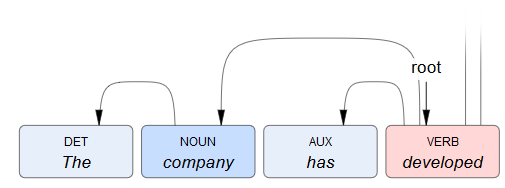Dependency representation
Here is an example of representing dependencies—the output of syntactic analysis—with arrow arcs.
If you perform the deep linguistic analysis of this sentence:
The company has developed an entirely new category of products.
you'll get a response like this:
{
"success": true,
"data": {
"content": "The company has developed an entirely new category of products.",
"language": "EN",
"tokens": [
{
"syncon": "noun.concepts.cause",
"start": 0,
"end": 3,
"type": "ART",
"lemma": "The",
"pos": "DET",
"id": 0,
"head": 1,
"dep": "det"
},
{
"syncon": "noun.organization.company",
"start": 4,
"end": 11,
"type": "NOU",
"lemma": "company",
"pos": "NOUN",
"id": 1,
"head": 3,
"dep": "nsubj"
},
{
"syncon": "noun.concepts.cause",
"start": 12,
"end": 15,
"type": "AUX",
"lemma": "has",
"pos": "AUX",
"id": 2,
"head": 3,
"dep": "aux"
},
{
"syncon": "verb.general_action.develop",
"start": 16,
"end": 25,
"type": "VER",
"lemma": "develop",
"pos": "VERB",
"id": 3,
"head": 3,
"dep": "root"
},
{
"syncon": "noun.concepts.cause",
"start": 26,
"end": 28,
"type": "ART",
"lemma": "an",
"pos": "DET",
"id": 4,
"head": 7,
"dep": "det"
},
{
"syncon": "adv.manner.fully",
"start": 29,
"end": 37,
"type": "ADV",
"lemma": "entirely",
"pos": "ADV",
"id": 5,
"head": 7,
"dep": "advmod"
},
{
"syncon": "adj.new",
"start": 38,
"end": 41,
"type": "ADJ",
"lemma": "new",
"pos": "ADJ",
"id": 6,
"head": 7,
"dep": "amod"
},
{
"syncon": "noun.object_group.category",
"start": 42,
"end": 50,
"type": "NOU",
"lemma": "category",
"pos": "NOUN",
"id": 7,
"head": 3,
"dep": "obj"
},
{
"syncon": "noun.concepts.cause",
"start": 51,
"end": 53,
"type": "PRE",
"lemma": "of",
"pos": "ADP",
"id": 8,
"head": 9,
"dep": "case"
},
{
"syncon": "noun.artifact.products",
"start": 54,
"end": 62,
"type": "NOU",
"lemma": "product",
"pos": "NOUN",
"id": 9,
"head": 7,
"dep": "nmod"
},
{
"syncon": "noun.concepts.cause",
"start": 62,
"end": 63,
"type": "PNT",
"lemma": ".",
"pos": "PUNCT",
"id": 10,
"head": 3,
"dep": "punct"
}
],
"phrases": [
{
"tokens": [
0,
1
],
"type": "NP",
"start": 0,
"end": 11
},
{
"tokens": [
2,
3
],
"type": "VP",
"start": 12,
"end": 25
},
{
"tokens": [
4,
5,
6,
7
],
"type": "NP",
"start": 26,
"end": 50
},
{
"tokens": [
8,
9
],
"type": "PP",
"start": 51,
"end": 62
},
{
"tokens": [
10
],
"type": "NA",
"start": 62,
"end": 63
},
{
"tokens": [],
"type": "CR",
"start": 63,
"end": 63
}
],
"sentences": [
{
"phrases": [
0,
1,
2,
3,
4,
5
],
"start": 0,
"end": 63
}
],
"paragraphs": [
{
"sentences": [
0
],
"start": 0,
"end": 63
}
]
}
}
- Use the
tokensarray because it contains the dependency structure of the sentence. -
Create a box for each token.

-
Label the box with the token text. This can be extracted from the value of the
contentproperty of the outerdataobject using thestartand theendproperties of the token.
-
To decorate the box:
-
You can assign a color corresponding to the part-of-speech, that is the value of the
posproperty. For example, you can use pink for verbs, light blue for nouns, etc.
-
You can also put the part-of-speech tag as an additional label inside the box.

-
You can create a tooltip with the token's
lemmaproperty.
-
-
Put a special mark over the token with the property
depset toroot
-
For all the non-root tokens, draw a dependency arc starting from the box of the token which
idproperty value is equal to the value ofheadproperty.
For example, if the current token hashead= 3, start drawing the arc from the box of the token withid= 3 and put the arrow head in the current token's box.
-
Decorate the arcs with the names of the dependencies you find in the
depproperty and you're done.
